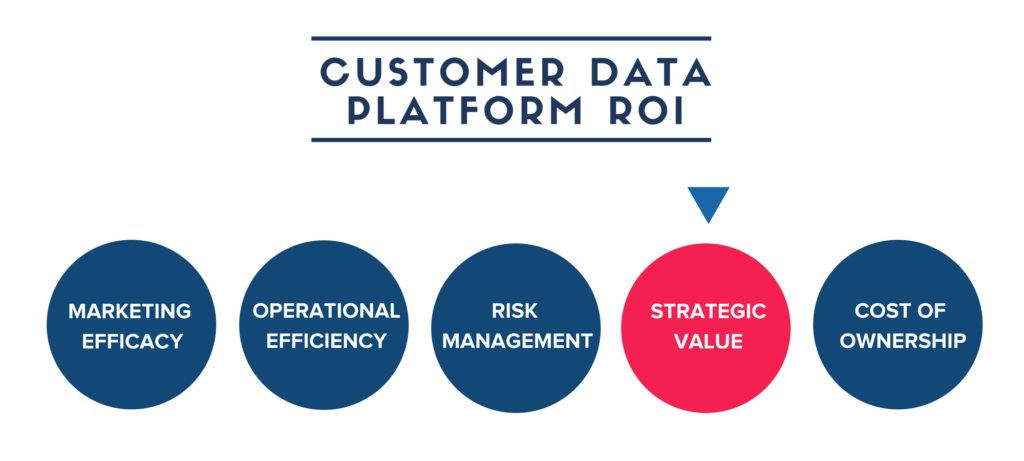CDP ROI: Strategic value
This blog is part four of a five-part series detailing how a CDP provides companies with a strategic advantage, leading to higher profits and competitive barriers to entry.

This blog is part four of a five-part series designed to help you build a better business case for data management. The first post covered marketing efficacy, the second marketing efficiency, and the third risk management. The fifth blog covers total cost of ownership.

Marketing efficiency and efficacy are important reasons for implementing a customer data platform. But these are tactical concerns, managed by a subset of the business under relatively short time horizons.
Strategic initiatives are, by contrast, stewarded by top management. Their success or failure can be measured by the business’ overall ability to generate high-profit margins relative to competitors and, in turn, the company’s market value.
High-profit margins are evidence of barriers to entry—what every CEO and Board wishes they had more of. As Warren Buffet famously said, the job of good management is to create “economic moats around the castle.” CDPs can help companies build these economic moats by creating demand-side barriers and supply-side competitive advantages.
Demand-side barriers
Demand-side barriers exist when companies have access to market demand that their competitors do not. It is often mistaken for branding; that can be part of it, but anyone can run brand advertising. Much harder to replicate are demand-side barriers created by a customer data advantage. According to research by Columbia University’s Bruce Greenwald, these come in the form of habit, switching costs, and search costs.
Amazon has created a moat around its business by exploiting all three:
- Search costs: You know Amazon will have everything you want at a low price, and you know it will always be easy to find what you want thanks to all the personalization, wish lists, and recommendations. This typically makes it easier to find what you’re looking for on Amazon than anywhere else.
- Habit: Amazon Prime makes it easy to buy again and again without a second thought.
Prime is perfect for mobile because you can order on the go easily without worrying about shipping costs or how long it will take to receive your order. To further reinforce this habit, Amazon sends push notifications letting you know when your package has shipped, been delayed, or has arrived. - Switching costs: Amazon saves your preferences and credit card information to make things quick and easy. The more you connect with Amazon—be it through a tablet or a mobile device or your desktop—the harder it becomes to walk away.
What’s remarkable about Amazon is how easily customers could leave Amazon were it not for Amazon’s data advantage. Amazon is keenly aware of this advantage and has continued to it via differentiators like proprietary content and technology hardware in the home. In e-commerce, the next best site is always just a click away. Amazon has organized and applied its customer data to build and meaningful relationship with its audience that cannot easily be replicated.
CDPs can help companies leverage their customer data to create better, “stickier” relationships that lead to a sustained competitive advantage (and high-profit margins) in the long-term.
Supply-side competitive advantage
Supply-side competitive advantages exist when a company has a cost advantage that allows it to produce and deliver products more cheaply than competitors. Customer knowledge—mapped to real identity and underpinned by a customer data platform—can help companies access new markets quicker and faster than competitors.
While the box office has seen studios like Paramount take huge losses in the past year, streaming studios have seen remarkable success. The key difference between Paramount releasing Zoolander 2 and Netflix releasing Bright is that Netflix knows exactly who its customers are and what they watch. Netflix’s content development and purchasing is based on event data including their customers’ viewing choices, when they watch, and how long they watch for, among many other factors. The team at Netflix bases all decisions, from UI to content to pricing on the millions of customer data points they collect. This data-driven approach has enabled Netflix to become one of the biggest producers and distributors of media in the world.
Using a customer data platform can give any company Netflix-like insights they can use to power data-driven decision-making, resulting in cost advantages new entrants can’t easily replicate.
To be clear, some companies land on a business model that has huge network effects and that’s their moat. Facebook and Airbnb are examples of two such companies; they can focus on growth marketing because one user acquired brings tens or hundreds of other users along with them. In that case, the north star is simple: acquire that user, then the next, then the next.
But most businesses don’t enjoy such network effects. To fortify their defenses, and avoid being commodified, brands need to create and invest in the kind of solid data strategy that a CDP can provide.



